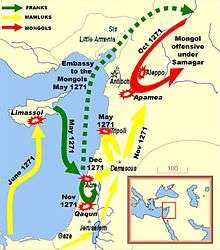Samagar
Samagar, also Cemakar, was a Mongol general of the Il-Khan ruler Abaqa Khan (1234–1282), mentioned as leading a Mongol invasion force in 1271, in attempted coordination with the Ninth Crusade.

Background
Little is known about Samagar, but he is mentioned in the context of attempted operations between the Mongols and the Crusaders.
In 1269, the English Prince Edward (the future Edward I), had led a small force to the Holy Land as part of the Ninth Crusade.[1] When he arrived in Acre on May 9, 1271, the situation in the Holy Land was particularly critical, as the Mamluk leader Baibars was besieging the Frankish noble Bohemond VI in the city of Tripoli.
Samagar's campaign
As soon as Edward arrived in Acre, he immediately sent an embassy to the Mongol ruler Abaqa Khan, leader of the southwestern Ilkhanate.[2] Edward's plan was to use the help of the Mongols to attack Baibars.[3] Abaqa answered positively to Edward's request in a letter dated September 4, 1271:
"After talking over the matter, we have on our account resolved to send to your aid Cemakar (Samaghar) at the head of a mighty force; thus, when you discuss among yourselves the other plans involving the afore-mentioned Cemakar be sure to make explicit arrangements as to the exact month and day on which you will engage the enemy."
— Letter from Abaqa to Edward I, 1271.[4]
In mid-October 1271, the Mongol troops under Samaghar arrived in Syria and ravaged the land from Aleppo southward. Abaqa, occupied by other conflicts in Turkestan, had only sent a minimal force of 10,000 Mongol horsemen under Samagar from the occupation army in Seljuk Anatolia, plus auxiliary Seljukid troops.[5] However, the Mongol advance triggered an exodus of Muslim populations (who remembered the previous campaigns of Kitbuqa) as far south as Cairo.[6] The Mongols defeated the Turcoman troops that protected Aleppo, putting to flight the Mamluk garrison in that city, and continued their advance to Maarat an-Numan and Apamea.[5]
The Mongols stayed only briefly, and never combined forces with Edward. When Baibars mounted a counter-offensive from Egypt on November 12, 1271, the Mongols under Samagar had already retreated beyond the Euphrates, unable to face the full Mamluk army. Edward returned to England in September, 1272.[7]
Samagar later expressed his willingness to the Mamluk Sultan Qalawun that he could help him to negotiate terms with Abaqa.
Coup
According to Marco Polo, Samagar was one of Mongol nobles who assisted Arghun in helping him escape from the captivity of Ahmed Tekuder. Buqa noyan persuaded him and others to help Arghun. Tekuder was defeated by Arghun's army, and he was eventually executed on August 10, 1284.
Notes
- Hindley, pp. 205-206
- "When he disembarked in Acre, Edward immediately sent envoys to Abagha (…) As he (Abagha) could not commit himself to the offensive, he ordered the Mongol forces stationned in Turkey under Samaghar to attack Syria in order to relieve the Crusaders” Jean Richard, p.446
- "Edward was horrified at the state of affairs in Outremer. He knew that his own army was small, but he hoped to unite the Christians of the East into a formidable body and then to use the help of the Mongols in making an effective attack on Baibars", Runciman, p.335
- Quoted in Amitai-Preiss, "Mongols and Mamluks", p.98
- Runciman p. 336
- Grousset p. 653
- Hindley, pp. 207-208
References
- Amitai-Preiss, Reuven (1987). "Mongol Raids into Palestine (AD 1260 and 1300)". Journal of the Royal Asiatic Society: 236–255.
- Grousset, René (1935). Histoire des Croisades III, 1188-1291 (in French). Editions Perrin. ISBN 2-262-02569-X.
- Grousset, René (1935). L'épopée des Croisades (in French). Editions Perrin. ISBN 2-262-01864-2.
- Hazard, Harry W. (editor) (1975). Volume III: The Fourteenth and Fifteenth Centuries. A History of the Crusades. Kenneth M. Setton, general editor. The University of Wisconsin Press. ISBN 0-299-06670-3.CS1 maint: extra text: authors list (link)
- Jackson, Peter (2005). The Mongols and the West: 1221-1410. Longman. ISBN 978-0-582-36896-5.
- Nicolle, David (2001). The Crusades. Essential Histories. Osprey Publishing. ISBN 978-1-84176-179-4.
- Richard, Jean (1996). Histoire des Croisades. Fayard. ISBN 2-213-59787-1.
- Riley-Smith, Jonathan (2005) [1987]. The Crusades: A History (2nd ed.). Yale Nota Bene. ISBN 0-300-10128-7.
- Riley-Smith, Jonathan (2005) [1996]. Atlas des Croisades (in French). Autrement. ISBN 2-86260-553-0.
- Riley-Smith, Jonathan (2002) (2002). The Oxford History of the Crusades. Oxford University Press. ISBN 0-19-280312-3.
- Jean-Paul Roux, L'Asie Centrale, Paris, 1997, ISBN 978-2-213-59894-9
- Runciman, Steven (1987 (first published in 1952-1954)). A history of the Crusades 3. Penguin Books. ISBN 978-0-14-013705-7. Check date values in:
|date=(help) - Tyerman, Christopher (2006). God's War: A New History of the Crusades. Harvard University Press. ISBN 0-674-02387-0.